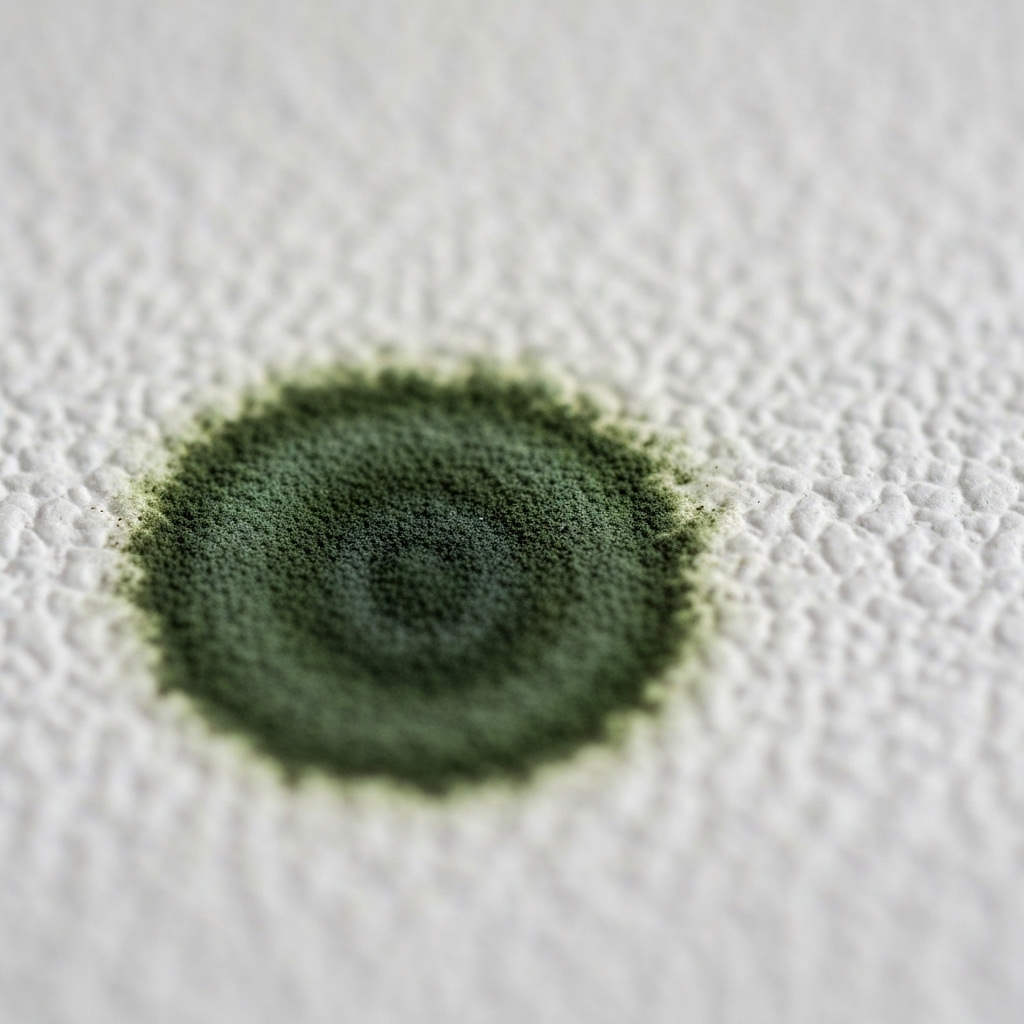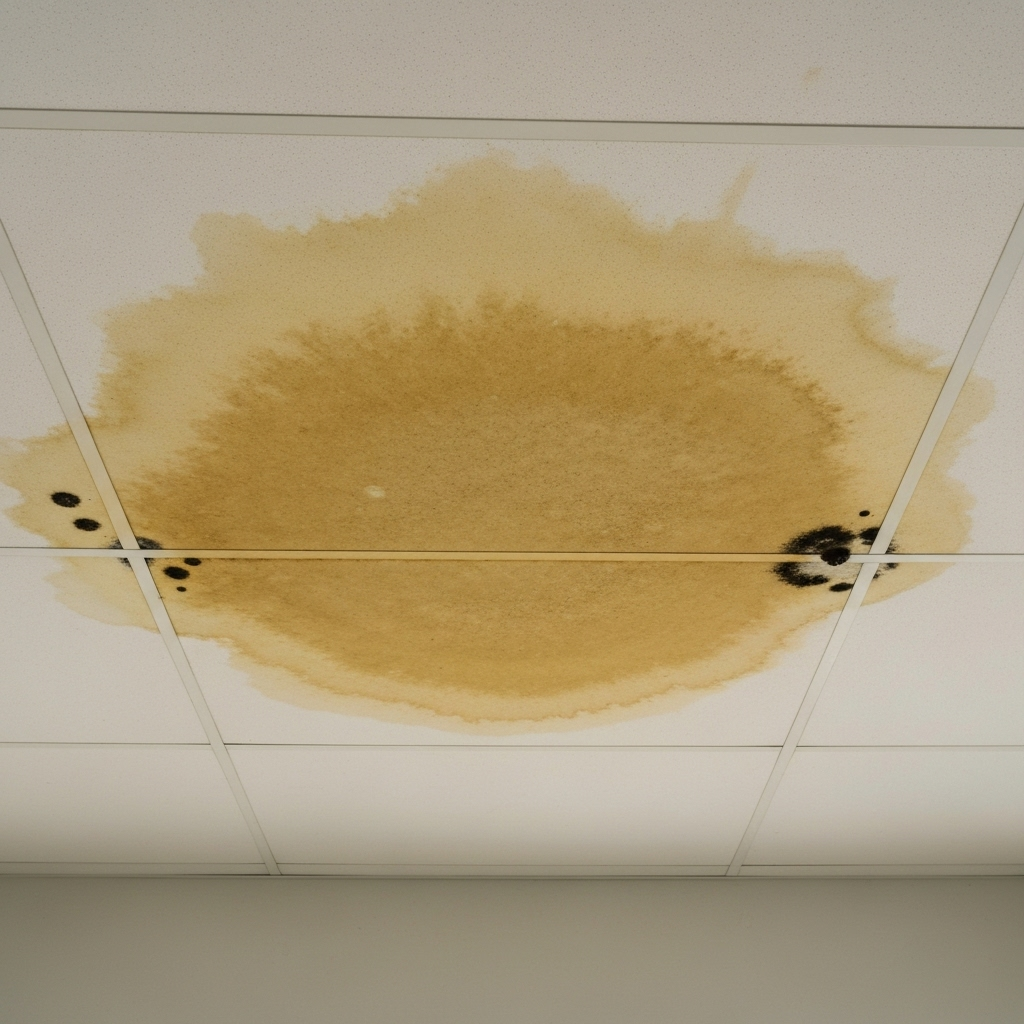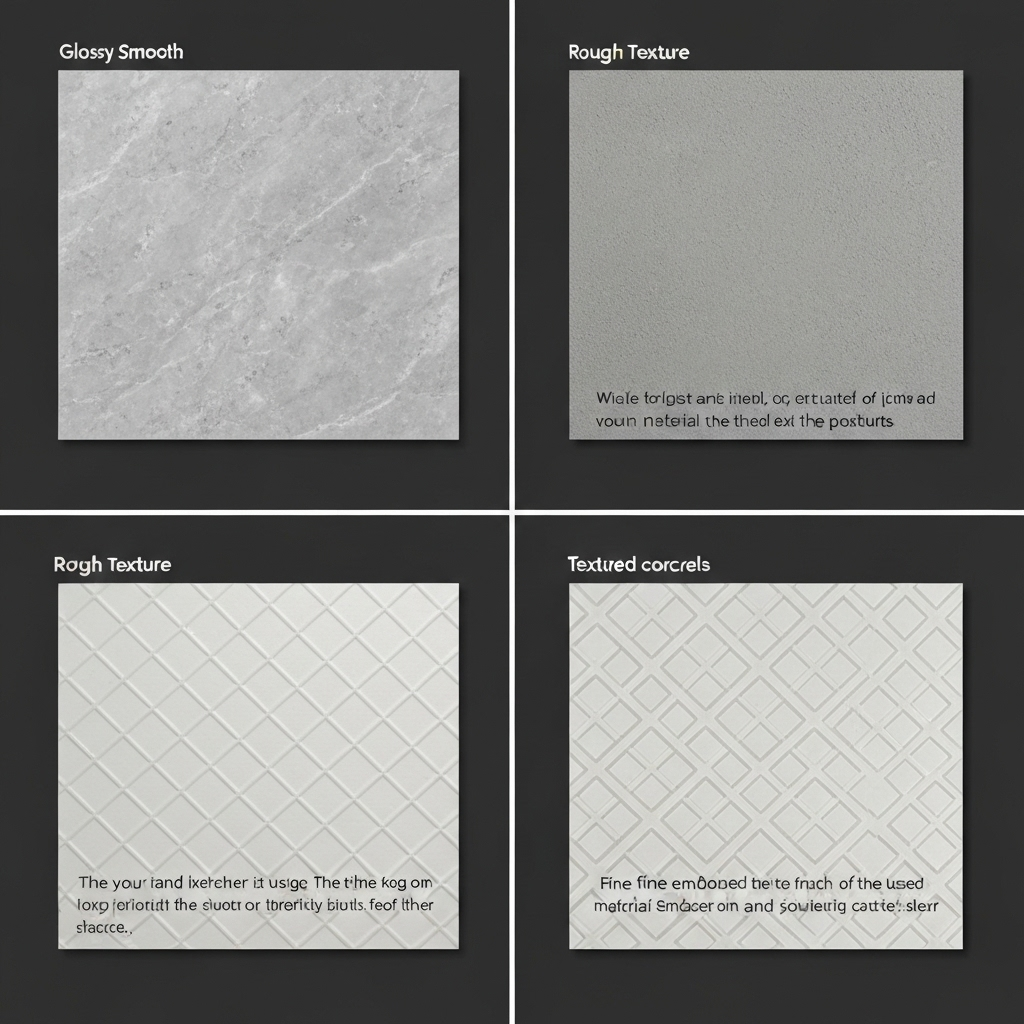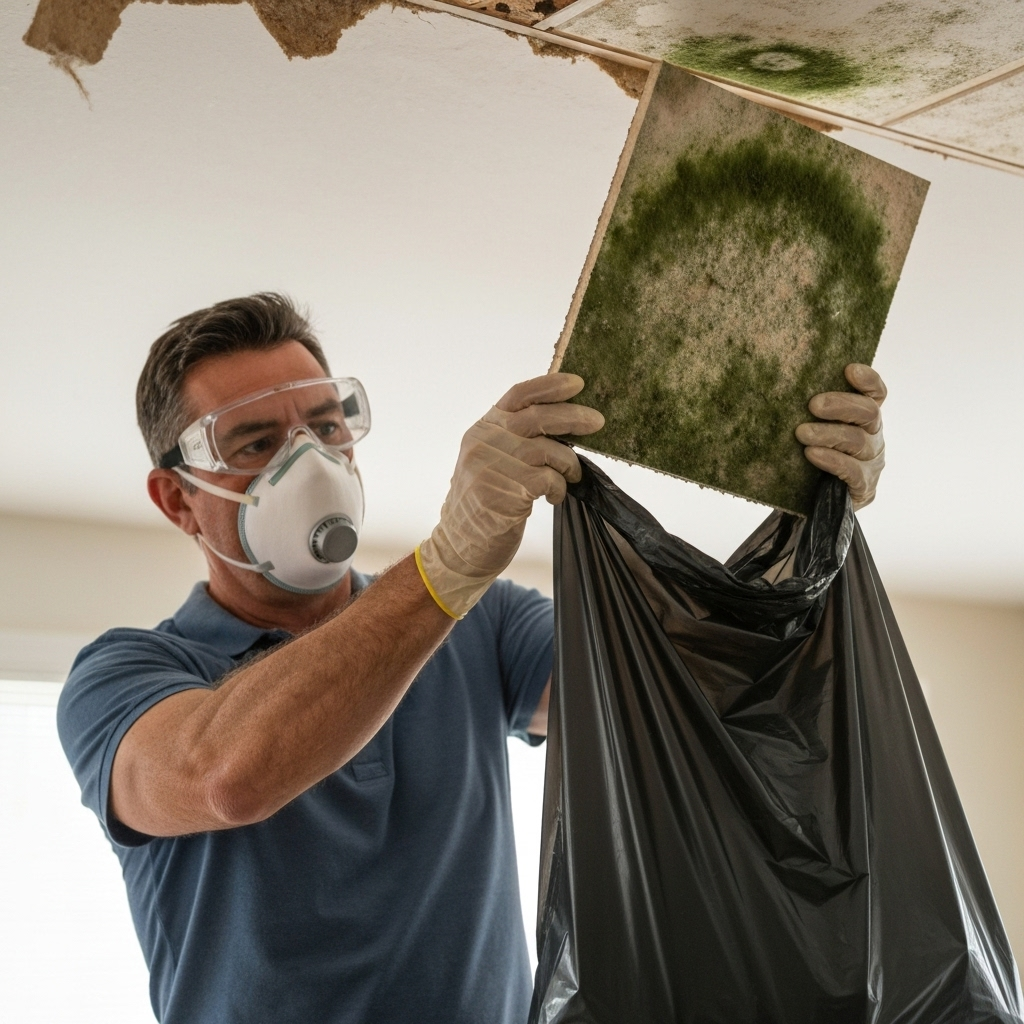Identification
What Does Ceiling Mold Look Like? A Homeowner's Guide to Identification
Discover what ceiling mold looks like with our guide. Learn to identify colors, textures, and when to call a pro for mold on ceiling tiles.
Fast facts
- Ceiling tiles are prone to mold due to their porous nature and proximity to common moisture sources like roofs and plumbing.
- Ceiling mold appears in many colors (black, green, yellow, white) and textures (fuzzy, powdery, slimy), not just one 'look'.
- Identifying and fixing the source of moisture is the most critical step for permanent mold removal.
- For mold covering more than 10 sq. ft., or if you suspect it's in your HVAC system, always call a professional.
- Never ignore a water stain, as it's a primary indicator that conditions are right for mold growth.
Photo examples




What Does Ceiling Mold Look Like? A Homeowner's Guide to Identification
You glance up and there it is: a strange, discolored spot on your ceiling. Your mind immediately starts to race. Is it just a shadow? A simple water stain from that storm last week? Or is it the one thing every homeowner dreads—mold?
Seeing a suspicious patch on a ceiling tile can be unsettling, but knowledge is power. Understanding what ceiling mold actually looks like is the first step toward addressing the problem and protecting your home and your family’s health. In this guide, we’ll walk you through the common signs, what to do, and when it’s time to call in the experts.
Why Are Ceiling Tiles a Hotspot for Mold?
It often seems like if mold is going to appear anywhere, it’s on a ceiling tile. There’s a good reason for this. Ceiling tiles, especially the porous, fibrous kind found in basements and drop ceilings, create a perfect storm for mold growth.
- Porous Material: Most ceiling tiles are made of materials like mineral fiber or fiberglass, which act like a sponge. Once they get wet, they can stay damp for a long time, providing a consistent moisture source for mold.
- Common Leak Sources: Ceilings are directly below potential problem areas. A slow roof leak, a leaky pipe in the floor above, or condensation from an HVAC unit can all drip down and saturate ceiling tiles.
- Trapped Moisture & Poor Airflow: The space above a drop ceiling (called the plenum) often has limited ventilation. This stagnant, dark, and damp environment is a five-star resort for mold spores looking for a place to settle down.
Common Visual Cues: What Ceiling Mold Looks Like
Mold doesn’t have a single, uniform appearance. It can vary dramatically in color and texture, which often leads to confusion. Forget the stereotypical image of a big, black, fuzzy patch; sometimes it’s much more subtle. Here’s what to look for.
Color Variations of Ceiling Mold
The color of mold is influenced by the species, the material it’s growing on, and its age. You might see:
- Black or Dark Green: This is the color most people associate with mold, often thinking of *Stachybotrys chartarum* (toxic black mold). While any black mold should be taken seriously, it’s important to remember that many different mold species are black, and not all are 'toxic'. The color alone can't confirm the species.
- Yellow, Brown, or Orange: These earthy tones are also common. This type of mold can sometimes appear slimy or almost rust-colored, especially if the area is very damp. It's often found growing on the paper backing of the ceiling tile.
- White or Gray: White mold can be particularly tricky. It can look powdery, fuzzy, or even stringy. It is very easy to mistake for dust or efflorescence (salt deposits left behind by evaporating water). A key difference is that mold will often grow and spread, while dust is more uniform.
Texture and Growth Patterns
Beyond color, look at the texture and the shape of the growth.
- Fuzzy or Hairy: This classic mold texture is a dead giveaway. If you see spots that look like they have depth or a velvety, fuzzy surface, you're almost certainly looking at mold.
- Powdery: As mentioned, some molds, especially mildew, have a powdery appearance. If you wipe it away and it quickly returns, it’s a strong sign of active growth.
- Spots and Clusters: Mold often starts as small, individual circular spots. As it grows, these spots can merge into larger, irregular patches.
- Discoloration and Staining: The very first sign is often a yellow or brown water stain. Mold may not be visible yet, but that stain tells you that the conditions are perfect for it. Eventually, you might see small black or brown specks appear on or around the edges of the old water stain.
Is It Mold, Mildew, or Just a Water Stain?
This is the million-dollar question. Here’s a quick breakdown:
- Water Stain: Typically flat against the surface with no texture. It usually has 'tide lines' or distinct brownish rings where the water has evaporated. A water stain is a warning sign.
- Mildew: Technically a type of mold, mildew is a surface-level fungus that is often powdery or downy and looks gray or white. It's common in areas with high humidity, like bathrooms.
- Mold: Tends to be fuzzier or slimier and can be a wide range of colors. Crucially, mold often penetrates deeper into the material it’s growing on, especially porous ceiling tiles.
The “smell test” can also be a powerful clue. Active mold growth produces microbial volatile organic compounds (MVOCs), which give off a distinct musty, earthy smell. If your room smells damp and musty even when it’s dry, you likely have a hidden mold problem.
If you're staring at a discolored patch and can't tell the difference, an AI-powered tool can provide a quick, unbiased assessment. Our Mold Detector AI analyzes photos to calculate the probability of mold, helping you decide on the next steps without guesswork.
What to Do When You Suspect Ceiling Mold: A Step-by-Step Plan
Okay, you’ve identified what you believe is ceiling mold. Don’t panic. Here’s a clear action plan.
Step 1: Safety First—Don't Touch It!
Resist the urge to poke, scrub, or scrape the mold. Disturbing it can release a cloud of spores into the air, spreading the problem to other parts of your home and potentially causing respiratory irritation. If you must get close to inspect it, wear an N-95 mask, safety goggles, and gloves.
Step 2: Find the Moisture Source
This is the most important step. You can clean mold all day, but if you don’t fix the water problem, it will always come back. Look for:
- Leaky roofs or flashing around chimneys/vents.
- Leaking plumbing from a bathroom or kitchen on the floor above.
- Condensation on pipes or HVAC ducts in the ceiling.
- High humidity in the room (common in basements and bathrooms).
Step 3: Assess the Size of the Problem
The EPA provides a useful guideline: if the moldy area is less than 10 square feet (roughly a 3-foot by 3-foot patch), a handy homeowner may be able to handle it. If it’s larger than that, it’s time to call a professional.
For ceiling tiles, this might mean one or two affected tiles could be a DIY job. If you see mold spreading across multiple tiles, it's a job for an expert.
When to Call a Professional Mold Remediation Expert
While a small, isolated spot might be manageable, certain situations absolutely require a professional. Call an expert if:
- The mold covers more than 10 square feet.
- The mold comes back after you’ve cleaned it.
- You suspect the mold is inside your HVAC system (a very serious issue).
- The moisture problem is from a major event, like a sewage backup or significant flood.
- You or members of your household are experiencing health symptoms associated with mold exposure, such as persistent headaches, coughing, or allergic reactions.
- You simply don't feel comfortable or equipped to handle the job safely.
Professionals have the training, specialized equipment (like HEPA air scrubbers), and proper containment procedures to remove the mold safely and effectively without cross-contaminating your home.
Dealing with ceiling mold can feel overwhelming, but by identifying it early and understanding the cause, you can take control of the situation. Remember to prioritize safety and address the underlying moisture issue to keep your home healthy and mold-free.
Not sure if that's mold? Upload your photo to Mold Detector AI and get instant results.
Ready to put this into action?
Not sure if that's mold? Upload your photo to Mold Detector AI and get instant results.
Launch Mold Detector AI